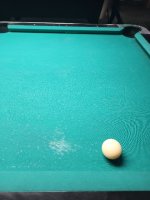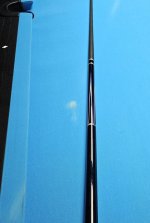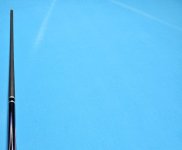I used the leftover cloth when my table was covered.I recently changed my cloth and have the old cloth being made into break pads for myself, and everybody who needs/wants one or two.
You are using an out of date browser. It may not display this or other websites correctly.
You should upgrade or use an alternative browser.
You should upgrade or use an alternative browser.
Why do some pool halls enforce the use of break pads?
- Thread starter spin-right-round
- Start date
I believe @dr_dave used a thermal camera to demonstrate the "burn" marks. If my memory still works... It might not
I have the thermal image video (from a group in Austria) showing hot spots here:
Awesome, thank you Doc. It's good to know my memory isn't completely gone!I have the thermal image video (from a group in Austria) showing hot spots here:
We keep them on our tables in our pockets for the reasons clearly explained here, as we like to keep our tables / cloth looking nice for as long as we can.I want to find the person that started this trend and ask them the reasoning behind forcing experienced players to use a loose piece of cloth under the cue ball to “protect the cloth”. If using proper break technique, on follow through the cue tip doesn’t really contact the cloth right below the cue ball, so it defeats the purpose of this so called break pad anyway.
From a physics perspective, a loose piece of cloth under the cueball would mean the CB loses momentum right after the time of contact (the loose piece of cloth acting like a dampener) so I find this idea completely absurd. If a player rips/puts a tear in the cloth because of the break, they should be liable for replacement. Plain and simple.
I’m no table mechanic so I may have this completely wrong. Willing to learn the reasoning if it’s technically sound.
We do require them for our tournaments and for our higher level players. Those are the players it is needed for the most - as they break very hard and often break from the exact same spot.
We do not require them for our recreational level play, as they rarely break hard enough to cause a burn mark.
It was my experience that these were the most likely to embrace the use of a break pad.We do not require them for our recreational level play, as they rarely break hard enough to cause a burn mark.
Requir all to use it might boost their ego too.
Exactly. I use them at home for that reason. It’s not that big a deal.The concern isn't the cue tip contacting the cloth, it's the burn marks caused by the cue ball.
For what it's worth, I don't know of a single room in Florida that requires them.
I think most people understand that burn marks are nothing more than cosmetic and don't really affect play at all.
I’ve seen it taken a step farther . They cut out a triangle and staple it to the back of the rack For people that put the rack at the back rail when they are loading the balls in then roll it forward and leave the white marks. hard to explain but you put it under the rack when you lay it down . then when you roll the rack forward into position it rolls out the back so you can lift the rack off. I never used it honestly. I sat the rack right on the spot it was supposed to be when I racked so I didn’t leave any marks.
I use the break pad that came with the Outsville template set as well. Not horrible consistent when playing 8ball, but always with both 9 and 10. I tend to experiment with the 8b break, but both the 9/10 are very dialed in locations.
I only recall being asked to use a break pad at a room once or twice. Not that it was an issue anyway but it's a tiny price to pay to have virgin cloth to play on.
Much ado
I only recall being asked to use a break pad at a room once or twice. Not that it was an issue anyway but it's a tiny price to pay to have virgin cloth to play on.
Much ado
At my place we would include a break patch with every tray of balls. Most people knew what it was for, some did not. We would explain the reason behind it. If they didn`t want to use it that was OK, although most people did. In a commercial setting, with about everybody breaking from the same few spots, the pads really extend the life of the cloth, or at least the way it looks.If a room owner wants you to use a break cloth...just do it.
I always wondered what that was about and how it worked.Exactly. I use them at home for that reason. It’s not that big a deal.
I’ve seen it taken a step farther . They cut out a triangle and staple it to the back of the rack For people that put the rack at the back rail when they are loading the balls in then roll it forward and leave the white marks. hard to explain but you put it under the rack when you lay it down . then when you roll the rack forward into position it rolls out the back so you can lift the rack off. I never used it honestly. I sat the rack right on the spot it was supposed to be when I racked so I didn’t leave any marks.only ever saw it at a local private club.
Coos Cues
Coos Cues
Have you been adversely mentally affected by a break cloth? You may be due compensation. Call today and speak to an experienced attorney about your case. You don't pay a penny until we recover your dignity for you! Brought to you by the law offices of Dewey, Cheatum and Howe!
That will only work on a Bumper Pool Table...seriously.... Are pads used in 1or 3C?4ftx4ft
Last edited:
they probably would if the narrative arouse that they should be usedThat will only work on a Bumer Pool Table...seriously.... Are pads used in 1or 3C?
We have a number of recreational players that use them in their bridge hand like a pool glove. They likely think that’s what they are meant for.I always wondered what that was about and how it worked.
We have a number of recreational players that use them in their bridge hand like a pool glove. They likely think that’s what they are meant for.
Back in the day we used to do that with a dollar bill with really shitty/sticky house sticks…
If I remember, I'll try to take a lower res picture of my home table. I don't use a break cloth. It's very obvious where cue is at on break. Also, there are 2 distinct white lines to where the 9 ball rack is. The white lines that the balls in the rack travel on, are not quite as distinct.
(The pics I have are too big to load on here, I have to figure out how to do lower res).
(The pics I have are too big to load on here, I have to figure out how to do lower res).
If I remember, I'll try to take a lower res picture of my home table. I don't use a break cloth. It's very obvious where cue is at on break. Also, there are 2 distinct white lines to where the 9 ball rack is. The white lines that the balls in the rack travel on, are not quite as distinct.
(The pics I have are too big to load on here, I have to figure out how to do lower res).
Attachments
I’ve heard that in many Asian poolrooms, the break pad is actually a 4+ foot long thin strip carefully laid down from the cue ball all the way to the head ball, to prevent break tracks. So by comparison, using a 3”x 3” square piece of cloth under the cue ball for breaking is no big deal.Trails to rack


